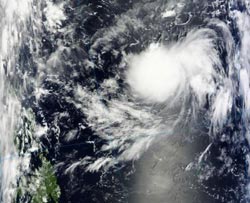NASA satellite sees Tropical Storm Jelawat form in northwestern Pacific

The MODIS instrument on NASA's Terra satellite captured this true-color image of Tropical Storm Jelawat on Sept. 20, 2012, at 01:50 UTC, before it had strengthened into a tropical storm. The Philippines is visible in the lower left corner.<br><br>Credit: NASA/Goddard/MODIS Rapid Response Team<br>
NASA's Terra satellite passed over Tropical Depression 18W before it strengthened into Tropical Storm Jelawat late in the day on Sept. 20, in the Philippine Sea (part of the western North Pacific Ocean basin).
On Sept. 20 at 01:50 UTC, as the depression was strengthening into a tropical storm, the Moderate Resolution Imaging Spectroradiometer (MODIS) instrument on NASA's Terra satellite captured a true-color image of the storm. The MODIS image showed a rounded shape, which indicates good circulation. There was also a band of thunderstorms east of the center of circulation.
On Sept. 21, Tropical Storm Jelawat had maximum sustained winds near 45 knots (51.7 mph/83.3 kph). Jelawat was located about 535 nautical miles east-southeast of Manila, Philippines, near 12.4 north latitude and 129.7 east longitude. It was moving to the west-southwest at 7 knots (8 mph/13 kph).
Forecasters used infrared satellite imagery, such as that from the Atmospheric Infrared Sounder instrument that flies aboard NASA's Aqua satellite to determine the initial position of the tropical storm. Infrared data from Sept. 21, 2012, showed that the strongest convection and coldest cloud top temperatures were in the northwestern and southeastern quadrants of the tropical storm. Those areas were experiencing the heaviest rainfall.
By 10 p.m. local time in Manila, Philippines (10 a.m. Eastern Time/U.S.) on Sept. 21, Jelawat's center was about 311 miles (500 km) east of Catarman capital of Northern Samar, near 12.4 north latitude and 129.7 east longitude. Northern Samar is a Philippine province in the Eastern Visayas region.
The Philippine Atmospheric Geophysical and Astronomical Services Administration issued a bulletin about Jelawat (known locally as Lawin) on Sept. 21 that noted “Estimated rainfall amount is from 10 to 25 mm (0.4 to 0.9 inches) per hour within the 600 km (373 miles) diameter of the Tropical Storm. Fishing boats and other small seacrafts are advised not to venture out into the eastern seaboard of Southern Luzon, Visayas and Mindanao due to big waves generated by Tropical Storm (Jelawat) Lawin.”
Jelawat is expected to track slowly west-northwestward over the weekend of Sept. 22 and 23 while the storm intensifies. The forecast track from the Joint Typhoon Warning Center keeps the center of Jelawat at sea, while almost tracking parallel to the Philippines.
Media Contact
More Information:
http://www.nasa.govAll latest news from the category: Earth Sciences
Earth Sciences (also referred to as Geosciences), which deals with basic issues surrounding our planet, plays a vital role in the area of energy and raw materials supply.
Earth Sciences comprises subjects such as geology, geography, geological informatics, paleontology, mineralogy, petrography, crystallography, geophysics, geodesy, glaciology, cartography, photogrammetry, meteorology and seismology, early-warning systems, earthquake research and polar research.
Newest articles

Bringing bio-inspired robots to life
Nebraska researcher Eric Markvicka gets NSF CAREER Award to pursue manufacture of novel materials for soft robotics and stretchable electronics. Engineers are increasingly eager to develop robots that mimic the…

Bella moths use poison to attract mates
Scientists are closer to finding out how. Pyrrolizidine alkaloids are as bitter and toxic as they are hard to pronounce. They’re produced by several different types of plants and are…

AI tool creates ‘synthetic’ images of cells
…for enhanced microscopy analysis. Observing individual cells through microscopes can reveal a range of important cell biological phenomena that frequently play a role in human diseases, but the process of…





















